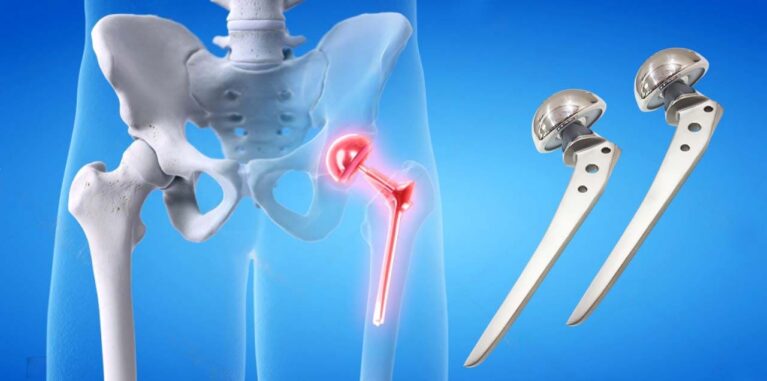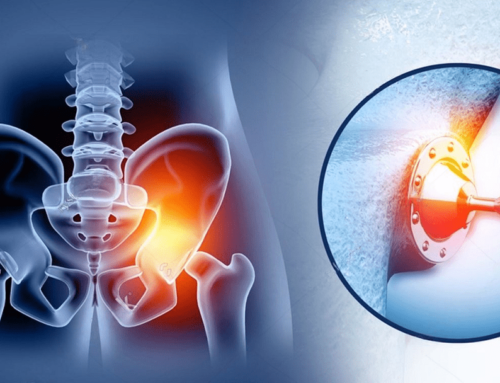A hip prosthesis, also known as a hip replacement, is a medical device used to replace a damaged or diseased hip joint. The primary goal of a hip prosthesis is to alleviate pain and restore function in individuals suffering from conditions such as osteoarthritis, rheumatoid arthritis, hip fractures, or other hip joint disorders.
A hip prosthesis typically consists of the following components:
Acetabular Component:
This is the socket part of the prosthesis, which replaces the damaged acetabulum (the cup-shaped part of the pelvis). It is usually made of metal and may have a liner made of plastic, ceramic, or metal to reduce friction.
Femoral Component:
This is the stem and ball part of the prosthesis that replaces the head and neck of the femur (thighbone). The stem is inserted into the femur, and the ball fits into the acetabular component, forming the new hip joint. The femoral component is often made of metal, with the ball sometimes being made of ceramic or metal.
Liner:
A liner is often placed inside the acetabular component to provide a smooth surface for the ball to move against. This can be made of various materials such as polyethylene (plastic), ceramic, or metal.
The hip replacement procedure can be performed using different surgical techniques, and the choice of prosthesis components can vary based on the patient’s age, activity level, and specific medical condition. Recovery and rehabilitation after hip replacement surgery are crucial for the success of the procedure, with physical therapy playing a significant role in regaining mobility and strength.
Types of Hip Prosthesis
Hip prostheses come in various types, tailored to fit the specific needs and conditions of patients. The main types of hip prostheses are:
Total Hip Replacement (THR):
- Cemented Prosthesis: Uses bone cement to attach the prosthetic components to the bone. It is often used in older, less active patients.
- Cementless (Press-Fit) Prosthesis: Designed to allow the bone to grow into the prosthesis, creating a natural bond. It is typically used in younger, more active patients.
- Hybrid Prosthesis: Combines both cemented and cementless techniques, with one component (usually the femoral stem) being cemented and the other (acetabular cup) being press-fitted.
Partial Hip Replacement (Hemiarthroplasty):
- Only the femoral head is replaced, not the acetabulum. This is often used for treating hip fractures, particularly in older patients who may not need a full replacement.
Resurfacing Hip Replacement:
- Involves capping the femoral head with a metal prosthesis and placing a metal cup in the acetabulum. This preserves more of the patient’s natural bone and is generally considered for younger, more active patients.
Bipolar Prosthesis:
- Bipolar hip Prosthesis is a type of partial replacement where the prosthetic femoral head has an additional articulation within the head itself, allowing for more movement and reduced wear on the acetabulum. It is often used for hip fractures.
Materials Used in Hip Prostheses:
- Metal-on-Polyethylene: A metal femoral head articulates with a polyethylene acetabular cup. This is the most common and cost-effective option.
- Metal-on-Metal: Both the femoral head and the acetabular cup are made of metal. This type was popular for its durability but has declined in use due to concerns about metal ion release.
- Ceramic-on-Ceramic: Both components are made of ceramic, which provides excellent wear resistance and reduced risk of metal ion release.
- Ceramic-on-Polyethylene: Combines a ceramic femoral head with a polyethylene acetabular cup, offering a balance of durability and reduced friction.
Surgical Approaches:
- Posterior Approach: The most common approach, providing good access to the hip joint but with a higher risk of dislocation post-surgery.
- Anterior Approach: Less common but gaining popularity due to a lower dislocation risk and potentially quicker recovery.
- Lateral Approach: Involves an incision on the side of the hip and is another option depending on the surgeon’s preference and the patient’s anatomy.
The choice of hip prosthesis type and material depends on various factors including the patient’s age, activity level, bone quality, and the specific pathology of the hip joint. The surgeon will evaluate these factors to determine the most appropriate type of prosthesis for each individual patient.
Benefits of hip prosthesis?
Hip prostheses offer several significant benefits for individuals suffering from severe hip joint conditions. These benefits include:
Pain Relief:
- One of the primary reasons for hip replacement surgery is to alleviate chronic hip pain caused by conditions such as osteoarthritis, rheumatoid arthritis, or hip fractures. A hip prosthesis can significantly reduce or eliminate this pain, improving the patient’s quality of life.
Improved Mobility:
- Patients often experience a substantial improvement in their ability to move and perform daily activities after receiving a hip prosthesis. This includes walking, climbing stairs, and other movements that were previously limited due to hip pain and stiffness.
Enhanced Functionality:
- By replacing the damaged joint surfaces with a prosthesis, the hip joint’s functionality is restored. This allows for smoother and more efficient movement, enabling patients to return to their normal activities and hobbies.
Increased Stability:
- A hip prosthesis can provide better joint stability, reducing the risk of falls and improving the patient’s confidence in their mobility.
Correction of Deformities:
- In cases where hip deformities are present, a prosthesis can help correct these issues, leading to a more normal and symmetrical gait.
Improved Quality of Life:
- The combination of pain relief, improved mobility, and enhanced functionality contributes to an overall better quality of life. Patients can often return to an active lifestyle and participate in activities they enjoy.
Long-term Durability:
- Modern hip prostheses are designed to be durable and can last many years, often over a decade, depending on the type of prosthesis and the patient’s activity level.
Reduction in Medication Use:
- With the pain and inflammation associated with hip conditions alleviated by the prosthesis, patients may reduce or eliminate their dependence on pain medications and anti-inflammatory drugs.
Psychological Benefits:
- The improvement in physical health and function can also positively impact the patient’s mental and emotional well-being, reducing anxiety and depression related to chronic pain and disability.
Economic Benefits:
- Although the initial cost of hip replacement surgery can be high, the long-term benefits often outweigh these costs. Reduced pain and improved mobility can lead to fewer medical visits, less need for pain medications, and a quicker return to work and daily activities.
Overall, a hip prosthesis can significantly enhance the quality of life for individuals suffering from debilitating hip joint conditions, offering them a chance to regain their independence and enjoy a more active and fulfilling life.




Leave A Comment